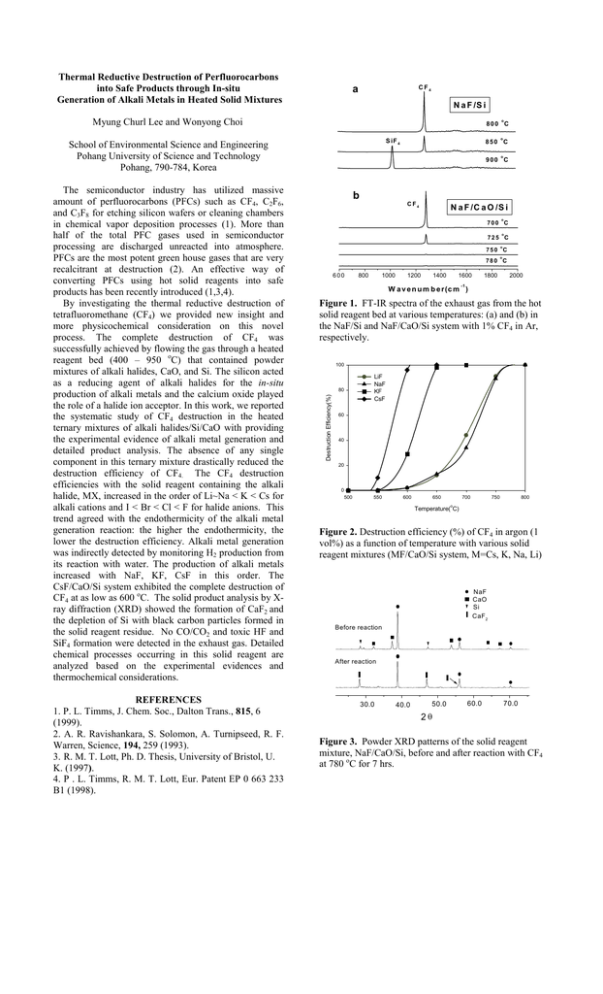Thermal Reductive Destruction of Perfluorocarbons into Safe Products through In-situ
advertisement

Thermal Reductive Destruction of Perfluorocarbons into Safe Products through In-situ Generation of Alkali Metals in Heated Solid Mixtures a CF4 N a F /S i Myung Churl Lee and Wonyong Choi o 800 C REFERENCES 1. P. L. Timms, J. Chem. Soc., Dalton Trans., 815, 6 (1999). 2. A. R. Ravishankara, S. Solomon, A. Turnipseed, R. F. Warren, Science, 194, 259 (1993). 3. R. M. T. Lott, Ph. D. Thesis, University of Bristol, U. K. (1997). 4. P . L. Timms, R. M. T. Lott, Eur. Patent EP 0 663 233 B1 (1998). 850 C o 900 C b C F4 N a F /C a O /S i o 700 C o 725 C o 750 C o 780 C 600 800 1000 1200 1400 1600 1800 2000 -1 W a v e n u m b e r (c m ) Figure 1. FT-IR spectra of the exhaust gas from the hot solid reagent bed at various temperatures: (a) and (b) in the NaF/Si and NaF/CaO/Si system with 1% CF4 in Ar, respectively. 100 LiF NaF KF CsF 80 Destruction Efficiency(%) The semiconductor industry has utilized massive amount of perfluorocarbons (PFCs) such as CF4, C2F6, and C3F8 for etching silicon wafers or cleaning chambers in chemical vapor deposition processes (1). More than half of the total PFC gases used in semiconductor processing are discharged unreacted into atmosphere. PFCs are the most potent green house gases that are very recalcitrant at destruction (2). An effective way of converting PFCs using hot solid reagents into safe products has been recently introduced (1,3,4). By investigating the thermal reductive destruction of tetrafluoromethane (CF4) we provided new insight and more physicochemical consideration on this novel process. The complete destruction of CF4 was successfully achieved by flowing the gas through a heated reagent bed (400 – 950 oC) that contained powder mixtures of alkali halides, CaO, and Si. The silicon acted as a reducing agent of alkali halides for the in-situ production of alkali metals and the calcium oxide played the role of a halide ion acceptor. In this work, we reported the systematic study of CF4 destruction in the heated ternary mixtures of alkali halides/Si/CaO with providing the experimental evidence of alkali metal generation and detailed product analysis. The absence of any single component in this ternary mixture drastically reduced the destruction efficiency of CF4. The CF4 destruction efficiencies with the solid reagent containing the alkali halide, MX, increased in the order of Li~Na < K < Cs for alkali cations and I < Br < Cl < F for halide anions. This trend agreed with the endothermicity of the alkali metal generation reaction: the higher the endothermicity, the lower the destruction efficiency. Alkali metal generation was indirectly detected by monitoring H2 production from its reaction with water. The production of alkali metals increased with NaF, KF, CsF in this order. The CsF/CaO/Si system exhibited the complete destruction of CF4 at as low as 600 oC. The solid product analysis by Xray diffraction (XRD) showed the formation of CaF2 and the depletion of Si with black carbon particles formed in the solid reagent residue. No CO/CO2 and toxic HF and SiF4 formation were detected in the exhaust gas. Detailed chemical processes occurring in this solid reagent are analyzed based on the experimental evidences and thermochemical considerations. o S iF 4 School of Environmental Science and Engineering Pohang University of Science and Technology Pohang, 790-784, Korea 60 40 20 0 500 550 600 650 700 750 800 o Temperature( C) Figure 2. Destruction efficiency (%) of CF4 in argon (1 vol%) as a function of temperature with various solid reagent mixtures (MF/CaO/Si system, M=Cs, K, Na, Li) NaF CaO Si CaF 2 Before reaction After reaction 30.0 40.0 50.0 60.0 70.0 2θ Figure 3. Powder XRD patterns of the solid reagent mixture, NaF/CaO/Si, before and after reaction with CF4 at 780 oC for 7 hrs.





